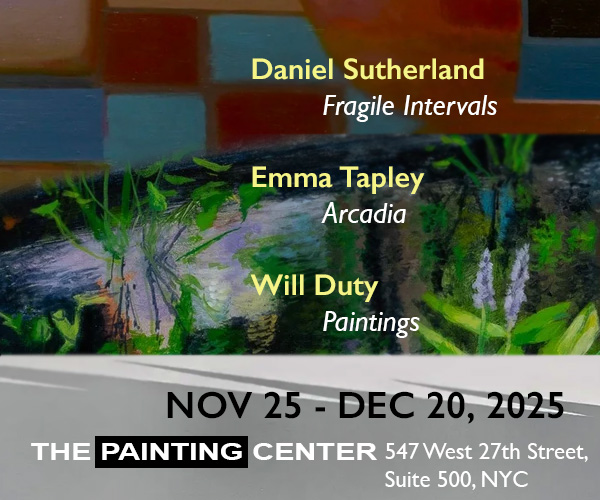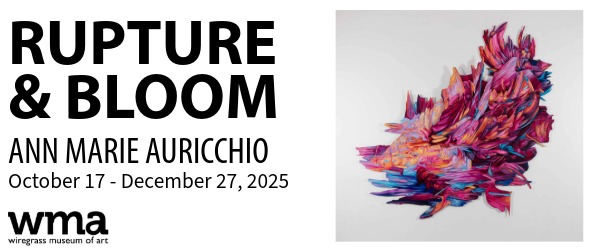Contributed by Max Liebermann* / The sounds of installation at Art Miami include airplanes flying overhead, whirring impact drivers, drywall screws squeaking into the MDF (medium density fiberboard) walls, beeping electricians on scissor lifts, din, fans, and people talking. The larger-scale Art Basel adds beeping forklifts, humming go-carts whipping from aisle to aisle, and hushed talk. The people making these noises, or operating the machines that make them, are art handlers.
[Image at top: Stretching a large-scale painting that arrived rolled up in a tube.]
At many of the smaller fairs booth owners install the work themselves, but here’s someone doing it at Art Basel.
For Art Basel and most of its satellite fairs, galleries and dealers generally pay for the services of one of four companies � Masterpiece International, Dietl, Atelier 4, or Gander and White � which in turn sub-contract freelance art handlers, flying them down, putting them up in hotels, and assigning them to different booths. Art handlers with no special experience are routinely hired and men constitute the majority of art handlers at any fair � probably on account of their relative brawn. Yet they vary widely in size and, though the job has often been described as predominantly “lifting inordinately heavy things for other people,” they certainly are not uniformly fit. Art handlers at Art Basel, men and women, are generally white.
Whoever the handlers are, they have to be careful not to stray outside their professional turf. Local unionized workers have to install and paint the walls for the booths, and handle electricity, HVAC, carpeting, and floor repair. Booth-wise, all the art handler is supposed to do is touch up the paint when things are wrapping up. In practice, conjuring a local union guy can be tough, so the handlers sometimes end up discreetly doing things they aren�t strictly supposed to do. At Art Miami, a non-union fair, discretion is not required or observed. Art handlers and booth owners can be seen filching paint buckets and rollers abandoned by non-union painters to finish their walls, which would be unheard of at a union fair like Art Basel. Regardless of the particular fair, because most of the walls are painted white and all the lights are spotlights, over-illumination (a medically recognized environmental phenomenon that leads to headaches, migraines, fatigue, anxiety, and stress) sets in, and many art handlers look dazed and mildly disoriented by the end of the day, finding it hard to focus on specific tasks. In turn, the fair itself often acquires a hazy, surreal feeling in the early evening.
Art fair work is by nature transient; there just aren�t enough fairs to afford installers full employment. They generally split their time between work in museums and galleries and working for the four big shipping/crating companies, which exponentially surge their personnel strength during the big fairs. New York City is practically the only place where a freelance art handler can get reliably steady work, and can count on the standard art fair rate of $25 an hour, which means that city has the biggest supply of the required labor. That’s why, for Art Basel, virtually all the art handlers are flown down from New York. As a result, Art Basel becomes a kind of convention for New York art handlers, and thus an opportunity for both seething and networking. An art handler will see every gallerist who never called him back, every jerk who worked him for eighteen hours a day, three days running. But he�ll also encounter good friends and fellow handlers � brothers and sisters in arms who make the thirteen-hour days with demanding booth owners bearable. And while plenty of art handlers do not make art or especially care about it, many others are artists, writers, musicians, or craftsmen. For them, the fairs present opportunities to meet new creative colleagues and catch up with those they already know.
At Art Basel, each art handling company has its headquarters in the back complex of storage rooms with walls fifty feet high, some rooms as big as regulation baseball diamonds. The whole area is redolent of pizza � along with sandwiches the en masse meal of choice � and for better or worse facilitates communication. (Art Miami has no such headquarters, and is a much lonelier fair for the art handler.) While art handlers don�t rate five-star hotels, and are dispersed among relatively inexpensive chains in and around Miami, there remains a hierarchy and points of relative pride. For example, art handlers often keep their logo-emblazoned shirts on while socializing. Explaining his decision to shift to Masterpiece this year, one art handler said, “I just couldn’t do another year in Seagull,” referring to Dietl’s customary hotel of choice.
While installing art is often very quick, time can also slow down as placement decisions are being made, work orders are filled, and administrative arguments erupt. The art handler is on call, and waits as long as it takes to get the booth installed to the satisfaction of the booth owner. Working for a booth owner is a crapshoot. Some come to the fair with a very clear plan, including realistic expectations and specific designs. Others do not. (A few newbie galleries this year naively decided to bring half-ton light boxes that required three times as many people to unload them from the crate than usual.) Some are easygoing, big-hearted people, while others give the impression that there�s nothing underneath their chests. Aesthetic and ergonomic standards are also highly variable. Some people want carpeting, others vinyl pieces installed on the floors. Some bring wallpaper, which not every art handler will know how to install.
Almost every art handler knows how to hang a painting, when to put foam blocks down for work to safely rest on, when to wear nitrile gloves, how to use a drill, and approximately how much weight a drywall screw can bear. They all get that the bubble side of the wrap goes out when packing art work. But contemporary art � especially the kind presented at international art fairs � is so predictably non-standard that most of this knowledge is only marginally useful. So what would a trained art handler be expected to possess to work the fair? First, his own tool kit, containing standard tools, and cleverly stocked for screwball exigent situations with things like European star drill bits. Less tangibly, a good art handler must have abundant patience, generosity, and kindness, and a willingness to compromise and please the people she is working for � never saying no, cracking jokes at the right time, and smartly executing tasks like adjusting the height of a painting seven or eight. A consummate art handler must also be an improviser. Art handlers who are also artists are more likely to excel in this area because they tend to be innately creative people. Technical know-how can only get the handler so far before she is asked to hang, for the first time in her life, a six-foot shroud made out of toilet paper. She has no choice but to figure it out.
Part Two (later this week): Deinstalling the show.
* Not the reporter’s real name.
Related posts:
Quick study: Miami round-up
Part 1: Sharon Louden finds color and abstraction at Pulse and Art Basel Miami(2015)
Part 2: “Untitled — the best fair in Miami Beach” (2015)
Part 3: A selection from NO MAN’S LAND, Untitled, and ABMB (2015)
Part 4: Artist-run @ Satellite in Miami (2015)
——
Two Coats of Paint is licensed under a Creative Commons Attribution – Noncommercial-No Derivative Works 3.0 United States License. To use content beyond the scope of this license, permission is required.


























